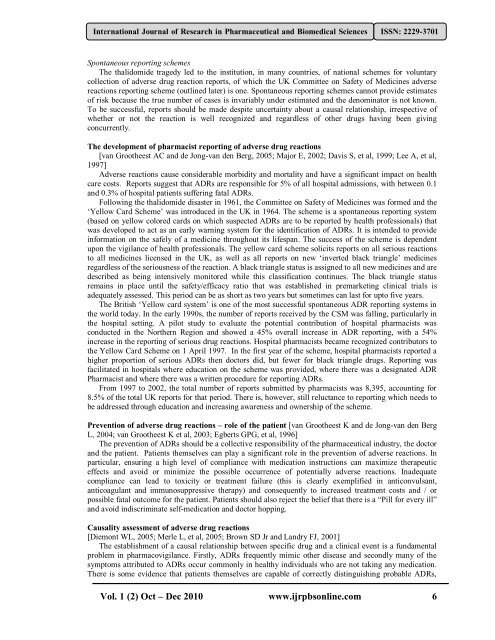Monitoring of Suspected Adverse Drug Reactions in Oncology Unit ...
Monitoring of Suspected Adverse Drug Reactions in Oncology Unit ...
Monitoring of Suspected Adverse Drug Reactions in Oncology Unit ...
You also want an ePaper? Increase the reach of your titles
YUMPU automatically turns print PDFs into web optimized ePapers that Google loves.
International Journal <strong>of</strong> Research <strong>in</strong> Pharmaceutical and Biomedical Sciences ISSN: 2229-3701<br />
Spontaneous report<strong>in</strong>g schemes<br />
The thalidomide tragedy led to the <strong>in</strong>stitution, <strong>in</strong> many countries, <strong>of</strong> national schemes for voluntary<br />
collection <strong>of</strong> adverse drug reaction reports, <strong>of</strong> which the UK Committee on Safety <strong>of</strong> Medic<strong>in</strong>es adverse<br />
reactions report<strong>in</strong>g scheme (outl<strong>in</strong>ed later) is one. Spontaneous report<strong>in</strong>g schemes cannot provide estimates<br />
<strong>of</strong> risk because the true number <strong>of</strong> cases is <strong>in</strong>variably under estimated and the denom<strong>in</strong>ator is not known.<br />
To be successful, reports should be made despite uncerta<strong>in</strong>ty about a causal relationship, irrespective <strong>of</strong><br />
whether or not the reaction is well recognized and regardless <strong>of</strong> other drugs hav<strong>in</strong>g been giv<strong>in</strong>g<br />
concurrently.<br />
The development <strong>of</strong> pharmacist report<strong>in</strong>g <strong>of</strong> adverse drug reactions<br />
[van Grootheest AC and de Jong-van den Berg, 2005; Major E, 2002; Davis S, et al, 1999; Lee A, et al,<br />
1997]<br />
<strong>Adverse</strong> reactions cause considerable morbidity and mortality and have a significant impact on health<br />
care costs. Reports suggest that ADRs are responsible for 5% <strong>of</strong> all hospital admissions, with between 0.1<br />
and 0.3% <strong>of</strong> hospital patients suffer<strong>in</strong>g fatal ADRs.<br />
Follow<strong>in</strong>g the thalidomide disaster <strong>in</strong> 1961, the Committee on Safety <strong>of</strong> Medic<strong>in</strong>es was formed and the<br />
‘Yellow Card Scheme’ was <strong>in</strong>troduced <strong>in</strong> the UK <strong>in</strong> 1964. The scheme is a spontaneous report<strong>in</strong>g system<br />
(based on yellow colored cards on which suspected ADRs are to be reported by health pr<strong>of</strong>essionals) that<br />
was developed to act as an early warn<strong>in</strong>g system for the identification <strong>of</strong> ADRs. It is <strong>in</strong>tended to provide<br />
<strong>in</strong>formation on the safely <strong>of</strong> a medic<strong>in</strong>e throughout its lifespan. The success <strong>of</strong> the scheme is dependent<br />
upon the vigilance <strong>of</strong> health pr<strong>of</strong>essionals. The yellow card scheme solicits reports on all serious reactions<br />
to all medic<strong>in</strong>es licensed <strong>in</strong> the UK, as well as all reports on new ‘<strong>in</strong>verted black triangle’ medic<strong>in</strong>es<br />
regardless <strong>of</strong> the seriousness <strong>of</strong> the reaction. A black triangle status is assigned to all new medic<strong>in</strong>es and are<br />
described as be<strong>in</strong>g <strong>in</strong>tensively monitored while this classification cont<strong>in</strong>ues. The black triangle status<br />
rema<strong>in</strong>s <strong>in</strong> place until the safety/efficacy ratio that was established <strong>in</strong> premarket<strong>in</strong>g cl<strong>in</strong>ical trials is<br />
adequately assessed. This period can be as short as two years but sometimes can last for upto five years.<br />
The British ‘Yellow card system’ is one <strong>of</strong> the most successful spontaneous ADR report<strong>in</strong>g systems <strong>in</strong><br />
the world today. In the early 1990s, the number <strong>of</strong> reports received by the CSM was fall<strong>in</strong>g, particularly <strong>in</strong><br />
the hospital sett<strong>in</strong>g. A pilot study to evaluate the potential contribution <strong>of</strong> hospital pharmacists was<br />
conducted <strong>in</strong> the Northern Region and showed a 45% overall <strong>in</strong>crease <strong>in</strong> ADR report<strong>in</strong>g, with a 54%<br />
<strong>in</strong>crease <strong>in</strong> the report<strong>in</strong>g <strong>of</strong> serious drug reactions. Hospital pharmacists became recognized contributors to<br />
the Yellow Card Scheme on 1 April 1997. In the first year <strong>of</strong> the scheme, hospital pharmacists reported a<br />
higher proportion <strong>of</strong> serious ADRs then doctors did, but fewer for black triangle drugs. Report<strong>in</strong>g was<br />
facilitated <strong>in</strong> hospitals where education on the scheme was provided, where there was a designated ADR<br />
Pharmacist and where there was a written procedure for report<strong>in</strong>g ADRs.<br />
From 1997 to 2002, the total number <strong>of</strong> reports submitted by pharmacists was 8,395, account<strong>in</strong>g for<br />
8.5% <strong>of</strong> the total UK reports for that period. There is, however, still reluctance to report<strong>in</strong>g which needs to<br />
be addressed through education and <strong>in</strong>creas<strong>in</strong>g awareness and ownership <strong>of</strong> the scheme.<br />
Prevention <strong>of</strong> adverse drug reactions – role <strong>of</strong> the patient [van Grootheest K and de Jong-van den Berg<br />
L, 2004; van Grootheest K et al, 2003; Egberts GPG, et al, 1996]<br />
The prevention <strong>of</strong> ADRs should be a collective responsibility <strong>of</strong> the pharmaceutical <strong>in</strong>dustry, the doctor<br />
and the patient. Patients themselves can play a significant role <strong>in</strong> the prevention <strong>of</strong> adverse reactions. In<br />
particular, ensur<strong>in</strong>g a high level <strong>of</strong> compliance with medication <strong>in</strong>structions can maximize therapeutic<br />
effects and avoid or m<strong>in</strong>imize the possible occurrence <strong>of</strong> potentially adverse reactions. Inadequate<br />
compliance can lead to toxicity or treatment failure (this is clearly exemplified <strong>in</strong> anticonvulsant,<br />
anticoagulant and immunosuppressive therapy) and consequently to <strong>in</strong>creased treatment costs and / or<br />
possible fatal outcome for the patient. Patients should also reject the belief that there is a “Pill for every ill”<br />
and avoid <strong>in</strong>discrim<strong>in</strong>ate self-medication and doctor hopp<strong>in</strong>g.<br />
Causality assessment <strong>of</strong> adverse drug reactions<br />
[Diemont WL, 2005; Merle L, et al, 2005; Brown SD Jr and Landry FJ, 2001]<br />
The establishment <strong>of</strong> a causal relationship between specific drug and a cl<strong>in</strong>ical event is a fundamental<br />
problem <strong>in</strong> pharmacovigilance. Firstly, ADRs frequently mimic other disease and secondly many <strong>of</strong> the<br />
symptoms attributed to ADRs occur commonly <strong>in</strong> healthy <strong>in</strong>dividuals who are not tak<strong>in</strong>g any medication.<br />
There is some evidence that patients themselves are capable <strong>of</strong> correctly dist<strong>in</strong>guish<strong>in</strong>g probable ADRs,<br />
Vol. 1 (2) Oct – Dec 2010 www.ijrpbsonl<strong>in</strong>e.com 6

















